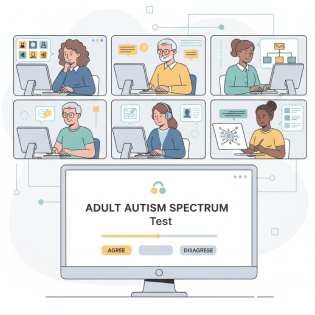What Adult Autism Screening Is and Why It Matters
Screening tools do not label anyone; they illuminate patterns that may merit further exploration. For many, trying a autism test for adults as a low-pressure starting point offers clarity about social communication, sensory differences, and repetitive behaviors. The goal is not to reduce a person to a score, but to organize observations and guide next steps. Thoughtful use of these instruments can also help friends, partners, and employers understand needs and make supportive adjustments.

Recognize Autism in Adulthood
When difficulties affect daily functioning, relationships, or workplace performance, seeking clarity can reduce uncertainty and stress. In those situations, clinicians often discuss testing for autism in adults to distinguish autistic traits from overlapping conditions like ADHD, anxiety, or OCD. Understanding what is driving challenges can transform support planning, enabling choices about communication strategies, sensory tools, and reasonable adjustments at work or school. The process also helps people align expectations with environments that fit their nervous systems.
Start the Test-
![]() Some adults discover traits later in life after years of compensating or masking, which can make superficial questionnaires less effective.
Some adults discover traits later in life after years of compensating or masking, which can make superficial questionnaires less effective. -
![]() For those who suspect a later-life discovery, a structured test of autism in adults can reveal consistent developmental patterns when combined with personal history.
For those who suspect a later-life discovery, a structured test of autism in adults can reveal consistent developmental patterns when combined with personal history. -
![]() Building a narrative that covers childhood, adolescence, and adulthood helps clarify the overall picture, especially when family or school records are available.
Building a narrative that covers childhood, adolescence, and adulthood helps clarify the overall picture, especially when family or school records are available.
Adult Autism Test Online: Pros and Cons
Self-assessments are most helpful as part of a layered approach. They can provide language for lived experiences, validate intuition, and frame questions for a professional. As an initial triage, a brief autism screening test for adults helps identify who might benefit from a comprehensive evaluation. These tools are also accessible, which matters for people facing long waitlists or limited local services. By organizing thoughts before an appointment, they can make clinical conversations more efficient.

Even so, questionnaires cannot substitute for clinical expertise. A formal workup considers medical history, developmental milestones, observation in different contexts, co-occurring conditions, and differential diagnoses. In clinical settings, a comprehensive asd test for adults is interpreted alongside interviews and collateral information to ensure accuracy. This approach reduces the risk of false positives or negatives due to masking, burnout, or misunderstood wording in self-report items.
How to Get Tested for Adult Autism?
Digital questionnaires are designed to be quick, accessible, and easy to complete on any device. They typically present statements about social interaction, communication, sensory preferences, and routines, asking you to rate how strongly you agree or how often the statements apply. Before seeking a formal evaluation, many people try an adult autism test online to become familiar with common question formats and reflect on day-to-day experiences. Honest responses matter, so it helps to answer from your typical behavior rather than how you think you “should” behave.
| Tool Type | Primary Focus | Estimated Time | Best For | Considerations |
|---|---|---|---|---|
| Short screener | Quick triage of traits | 3–10 minutes | Initial self-check | Good for starting; not diagnostic |
| Extended questionnaire | Broader trait coverage | 15–30 minutes | Pre-appointment prep | Offers nuance; still self-report |
| Context-focused survey | Work, relationships, sensory | 10–20 minutes | Planning supports | May highlight the environment fit |
| Masking/burnout add-ons | Camouflaging and fatigue | 5–15 minutes | Exploring hidden effort | Helpful for nuanced profiles |
Scores usually come with cutoffs that suggest whether further evaluation may be helpful, but they are not a diagnosis. When comparing platforms, an online autism test for adults should disclose who created it, what evidence supports it, and how data is handled to protect privacy. Results are most useful when you add context examples of situations that align with your responses, notes from partners or friends, and reflections on childhood. Treat the outcome as a map that points toward next steps, not a final verdict.

Preparing for an Assessment
If you are wondering how to test an adult for autism, start by creating a brief timeline of social, sensory, and learning experiences across childhood, adolescence, and adulthood. Include times when you felt burnt out, intensely focused, or unusually overwhelmed, noting triggers and recovery patterns. Bring this timeline to appointments and use it to explain day-to-day realities. The more concrete the examples, the easier it is for clinicians to see patterns beyond a questionnaire score.
Start the Test-
![]() Before your appointment, consider a low-stakes self-assessment to gather extra data points.
Before your appointment, consider a low-stakes self-assessment to gather extra data points. -
![]() Take a short autism for adult test to help articulate strengths, challenges, and supportive environments.
Take a short autism for adult test to help articulate strengths, challenges, and supportive environments. -
![]() After the evaluation, review written feedback, ask clarifying questions, and plan follow-ups as needed.
After the evaluation, review written feedback, ask clarifying questions, and plan follow-ups as needed.
Take Online Autism Test for Adults
Get StartedHigh-Functioning Autism for Adults: Key Insights
High compensation can complicate interpretation, particularly in late-identified adults. Because camouflaging can conceal traits, a high-functioning autism for adults test may miss the cumulative impact without a clinician probing for context. Many adults describe long periods of performing well outwardly while expending tremendous hidden effort, which often leads to exhaustion. Bringing real examples scripts you rehearse, routines you rely on, or the downtime required to recover can clarify the picture.

Comorbid conditions also shape results and supports. When reviewing a autism spectrum test adults, remember that ADHD, anxiety, depression, trauma, or sleep issues can influence how items are endorsed. A good evaluation looks for overlapping features and distinguishes which interventions address which challenges. This granular view empowers you to target the changes that will have the greatest everyday impact.

To safeguard your information, choose an autism test online adults that explains encryption, storage duration, and whether responses are used for research or advertising. Read the privacy policy carefully and consider using devices and browsers with strong security settings. If possible, take assessments in a calm environment and avoid rushing, since accuracy improves when you reflect on typical patterns rather than exceptional days. Many organizations reference an adult autism spectrum test with known sensitivity and specificity, indicating how well it identifies likely cases.
Start the TestExplore Affordable Autism Test Adults Options
If cost is a concern, a reputable free autism test for adults can help you gauge whether to seek a comprehensive evaluation. Some people use online screeners to prepare for conversations with primary care providers, who can generate referrals to neurodevelopmental specialists. This approach can shorten wait times and ensure you arrive with organized information about your history and needs.
Community organizations sometimes host an autism test adults free event or partner with clinics that offer reduced-fee screenings. You can also explore employee assistance programs, disability support services, or local nonprofits for guidance on affordable options. Regardless of cost, remember that screening is informational and not diagnostic, and that professional evaluation remains the most reliable route to answers and formal accommodations.
Frequently Asked Questions
- What is the difference between screening and diagnosis?Screening uses brief questionnaires to flag patterns that might suggest autistic traits, while diagnosis requires a comprehensive clinical evaluation by a qualified professional. A diagnostic assessment includes interviews, developmental history, behavioral observation, and differential diagnosis. Screeners are valuable starting points, but they cannot confirm or rule out a condition on their own.
- Can a self-assessment alone confirm that I am autistic?No, self-assessments cannot provide a formal diagnosis. They are best used to organize experiences, learn terminology, and decide whether to seek a professional evaluation. If a screener suggests elevated likelihood, consult a clinician who specializes in adult neurodevelopmental assessments.
- What should I bring to a clinical evaluation?Bring a summary of your history across life stages, specific examples of strengths and challenges, and any school records or past assessments. Notes about sensory needs, social energy, and recovery time are helpful, as are observations from someone who knows you well. A list of goals and questions ensures the evaluation addresses what matters most to you.
- How long does the professional process usually take?Timelines vary by region and provider. Initial screens may take minutes, while full evaluations can span several hours over one or more sessions. Reports are usually delivered within days to weeks, and follow-up appointments can clarify recommendations and discuss next steps.
- What can I do while waiting for an appointment?Use the time to document patterns in daily life, explore sensory and communication supports, and connect with peer communities. Practicing strategies that reduce overload such as structured routines, noise management, or planning buffers can improve well-being immediately. Arriving prepared helps clinicians understand your needs and deliver precise, actionable guidance.
The Latest News
 Free Adult Autism Screening: A Comprehensive Guide to Self-Assessment What Adult Autism Screening Means Autistic traits in adulthood can show up as lifelong patterns around sensory sensitivity, social communication differences, focused interests, and a preference for routine. Many adults wonder whether these patterns reflect neurodivergence, and a short self-assessme...
Free Adult Autism Screening: A Comprehensive Guide to Self-Assessment What Adult Autism Screening Means Autistic traits in adulthood can show up as lifelong patterns around sensory sensitivity, social communication differences, focused interests, and a preference for routine. Many adults wonder whether these patterns reflect neurodivergence, and a short self-assessme... - 27 October, 2025
- Comprehensive Guide to Adult Autism Self-Screening Online What an Online Autism Screening Is and Isn’t Autistic traits can show up in nuanced ways across a lifetime, shaping communication, sensory preferences, and patterns of focus. Many adults arrive at self-reflection after years of camouflaging or misattribution, and a well-designed digital quest...
- 24 October, 2025
- Detailed Guide to Adult Autism Screening and Next Steps What an Adult Autism Screening Can and Cannot Do Many adults reach a point in life when questions about communication style, sensory sensitivity, or routines spark curiosity about neurodivergence. A screening, whether self-directed or clinician-led, offers a structured way to reflect on patterns th...
- 23 October, 2025
Please Note
This website (autismtestadults.com) is not an official representative, creator or developer of this application, or product. All the copyrighted materials belong to their respective owners. All the content on this website is used for educational and informative purposes only.


